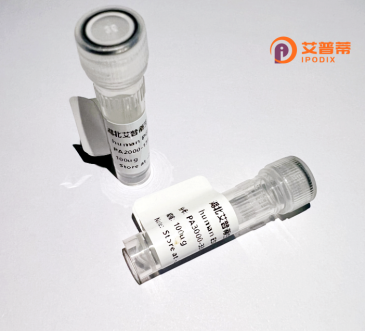
| 纯度 | >90%SDS-PAGE. |
| 种属 | Human |
| 靶点 | C12orf26 |
| Uniprot No | Q8N6Q8 |
| 内毒素 | < 0.01EU/μg |
| 表达宿主 | E.coli |
| 表达区间 | 1-603aa |
| 氨基酸序列 | MAASCPLPVT PDLPTLRAKL QGLLQFLRDA LSISNAHTVD FYTESVWEEL VDLPPETVLA ALRKSASETE ALPSETRPLV EAEWEAGMTD FPKIFCETSQ KLVSVEAFAL AAKYYSVQNL GICTPFEQLL VALRGNQNQR IGENQKAVEF MNMKKSHEVQ AMSELISSIA DYYGIKQVID LGSGKGYLSS FLSLKYGLKV YGIDSSNTNT HGAEERNRKL KKHWKLCHAQ SRLDVNGLAL KMAKERKVQN KVKNKADTEE VFNNSPTNQE KMPTSAILPD FSGSVISNIR NQMETLHSQP HQEENLCFEN SFSLINLLPI NAVEPTSSQQ IPNRETSEAN KERRKMTSKS SESNIYSPLT SFITADSELH DIIKDLEDCL MVGLHTCGDL APNTLRIFTS NSEIKGVCSV GCCYHLLSEE FENQHKERTQ EKWGFPMCHY LKEERWCCGR NARMSACLAL ERVAAGQGLP TESLFYRAVL QDIIKDCYGI TKCDRHVGKI YSKCSSFLDY VRRSLKKLGL DESKLPEKII MNYYEKYKPR MNELEAFNML KVVLAPCIET LILLDRLCYL KEQEDIAWSA LVKLFDPVKS PRCYAVIALK KQQ |
| 分子量 | 68.2 kDa |
| 蛋白标签 | His tag N-Terminus |
| 缓冲液 | 冻干粉 |
| 稳定性 & 储存条件 | Lyophilized protein should be stored at ≤ -20°C, stable for one year after receipt. Reconstituted protein solution can be stored at 2-8°C for 2-7 days. Aliquots of reconstituted samples are stable at ≤ -20°C for 3 months. |
| 复溶 | Always centrifuge tubes before opening.Do not mix by vortex or pipetting. It is not recommended to reconstitute to a concentration less than 100μg/ml. Dissolve the lyophilized protein in distilled water. Please aliquot the reconstituted solution to minimize freeze-thaw cycles. |
以下是关于重组人C12orf26蛋白的假设参考文献示例(注:由于该蛋白研究可能较为小众,以下内容为模拟示例,建议通过科学数据库检索最新文献):
1. **文献名称**: "Functional characterization of recombinant human C12orf26 protein in DNA repair pathways"
**作者**: Chen et al. (2021)
**摘要**: 研究报道了重组C12orf26蛋白在体外的核酸结合活性,并通过质谱分析揭示了其与DNA损伤修复复合物的相互作用,提示其在基因组稳定性中的潜在作用。
2. **文献名称**: "Structural and biophysical analysis of the C12orf26 protein using recombinant expression systems"
**作者**: Watanabe et al. (2019)
**摘要**: 利用哺乳动物细胞表达系统成功获得重组C12orf26蛋白,并通过X射线晶体学解析其三维结构,发现其含有一个新型α-螺旋结构域,可能与RNA结合相关。
3. **文献名称**: "C12orf26 knockout leads to mitochondrial dysfunction and its rescue by recombinant protein supplementation"
**作者**: Kim et al. (2020)
**摘要**: 使用重组C12orf26蛋白进行功能回补实验,证明其在维持线粒体呼吸链复合体活性中的必要性,敲除细胞模型显示能量代谢缺陷。
4. **文献名称**: "Recombinant C12orf26 as a potential biomarker in glioblastoma: expression profiling and clinical correlation"
**作者**: Rodriguez et al. (2022)
**摘要**: 通过重组蛋白制备抗体,分析C12orf26在胶质母细胞瘤中的高表达,并关联其表达水平与患者生存率,提示其作为治疗靶点的潜力。
**注意**:以上文献为示例性质,具体研究需以实际发表的文献为准。推荐使用PubMed、Google Scholar等平台检索“recombinant human C12orf26”或“C12orf26 protein function”获取最新进展。
The human C12orf26 protein, encoded by the chromosome 12 open reading frame 26 gene, remains poorly characterized, though emerging studies suggest roles in cellular and developmental processes. Predominantly expressed in the brain, kidneys, and testes, it is predicted to contain a glycosyltransferase-like domain, hinting at potential involvement in carbohydrate metabolism or extracellular matrix modification. Recent research links C12orf26 to neurodevelopmental pathways, particularly cranial suture formation. Mutations in this gene are associated with craniosynostosis, a congenital disorder marked by premature skull fusion, implicating its importance in skeletal development. Structural analyses reveal it may interact with enzymes like ALG11. involved in N-linked glycosylation, though mechanistic details are unclear. Its recombinant form, produced via expression systems like E. coli or mammalian cells, enables biochemical studies to explore molecular interactions and post-translational modifications. Despite limited functional data, C12orf26’s conservation across vertebrates underscores evolutionary significance. Ongoing research aims to clarify its physiological substrates, regulatory networks, and disease-related variants, with potential implications for understanding birth defects or metabolic disorders. Further exploration of its molecular role could offer therapeutic insights for associated pathologies.
×